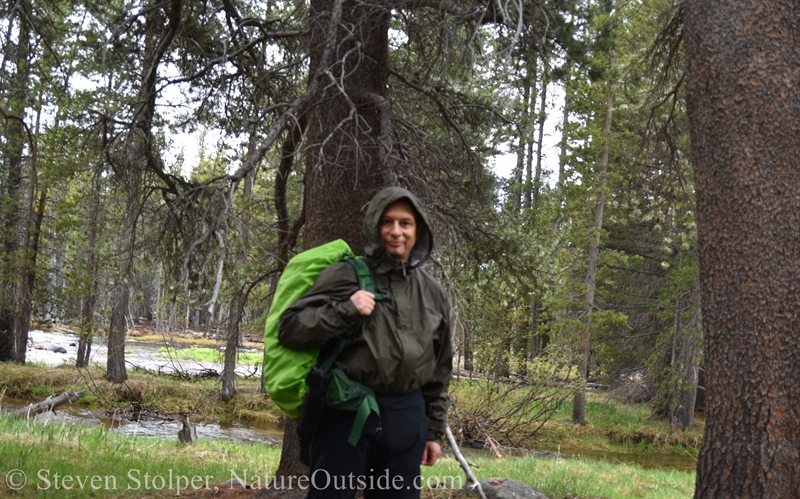
This article contains affiliate links.
In the school of the woods there is no graduation day.
– Horace Kephart
I had been rereading Kephart’s classic, Camping and Woodcraft, and now his words echo in my mind as Yosemite’s grand scenery slides past my car windows.
This trip is a last-minute impulse. Free from the restrictions imposed during the worst of the COVID pandemic, I head to Yosemite National Park to spend a few days alone in the mountains. I seek the restorative power of nature after long confinement. And I revel in the glorious June day.
A weekend Getaway
My destination is Yosemite’s high country. Between Tuolumne Meadows (elevation 8,600 feet) and Mount Lyell (elevation 13,114 feet) lies rugged country whose beauty holds me spellbound.
My drive takes me past Olmsted Point, with its grand view of Half Dome.
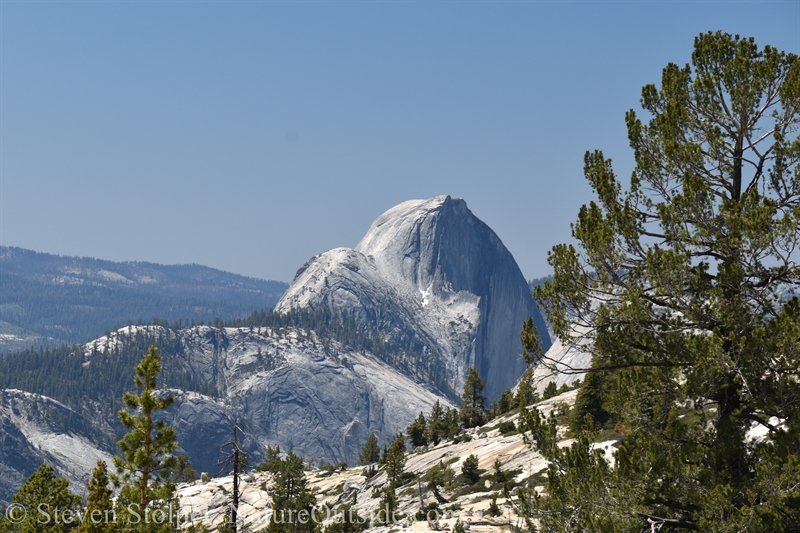
Half Dome seen from Olmstead Point
Unsurprisingly, I’m behind schedule. I started my drive late, and chose to stretch my legs by hiking to a grove of Giant Sequoia (Sequoiadendron giganteum) in another part of the park.
I decide to stop yet again. This time for lunch on the shore of Tenaya Lake. At this point I throw my schedule out the window. I resolve to meander at a relaxed pace for the rest of the day. After all, I have nowhere to go and all day to get there!
As I pack up after lunch, I notice foreboding clouds to the south and east.
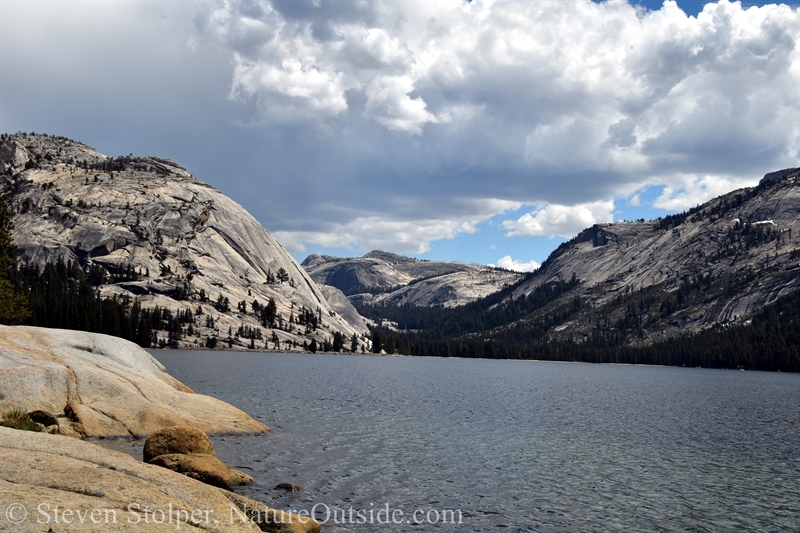
The sky is darkening over Tenaya Lake
Mountains Make Their Own Weather
There’s an old saying about mountains. I don’t recall how I first heard it. But I heed its inherent warning.
Mountains make their own weather.
In the mountains, nature is both scenery and dynamic force. It’s common at many higher elevations for mid-afternoon storms to disrupt an otherwise cloudless summer day. In some places, I can set my watch by when the line of thunderstorms roll-in each day. Often these storms pass overhead and disappear within an hour or two. But sometimes…
Summer thunderstorms catch incautious hikers unaware. And you ignore the weather at your peril. When the Thunderbird hovers overhead, it’s time to get going or seek shelter.
One of my most vivid memories from a four-day backpack in Glacier National Park is racing to climb over a mountain pass with a line of thunderstorms hard on our heels.
Storm in Tuolumne Meadows
I drive to Tuolumne Meadows. I hope the storms come and go before I get there. But I suspect I will arrive just before the storms reach the meadow. I hope to hike to the top of Lembert Dome. But the dome rises some 900 feet above the meadow. There’s no way I’ll climb it in the face of approaching storms.
I park the car and don my daypack. I can see the storms coming. I decide to explore the vicinity of Tuolumne Meadows until I can assess the severity of the storms and figure out how long they’ll be in the area. I won’t be getting as far from the tourists as I had hoped. But with limited park admission due to COVID, I find myself in the meadow largely alone.
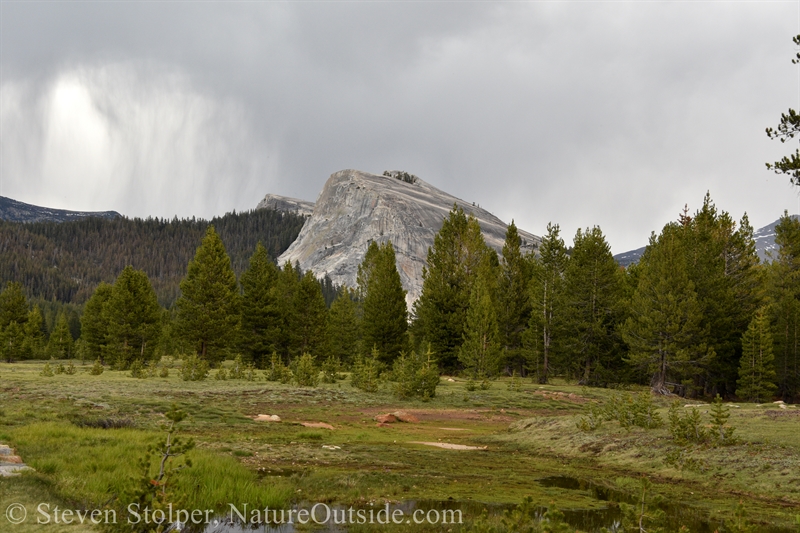
Rain in the distance behind Lembert Dome
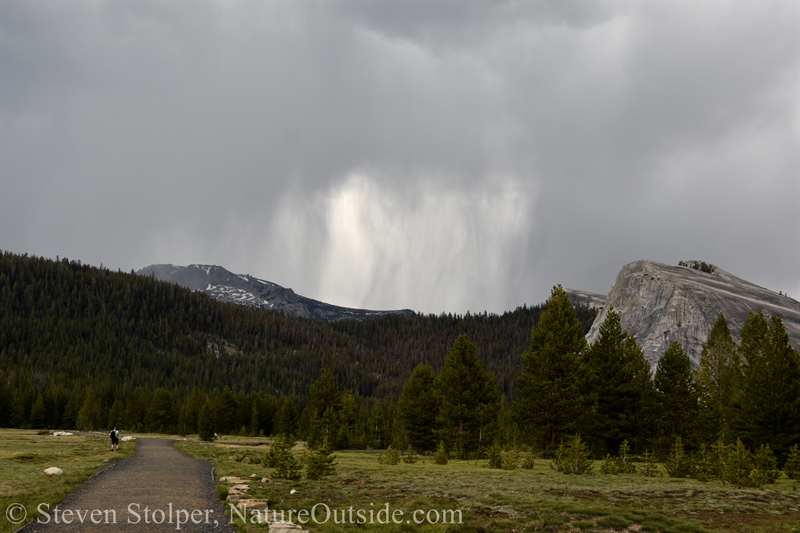
My pictures don’t do justice to the size of the rain showers in the area.
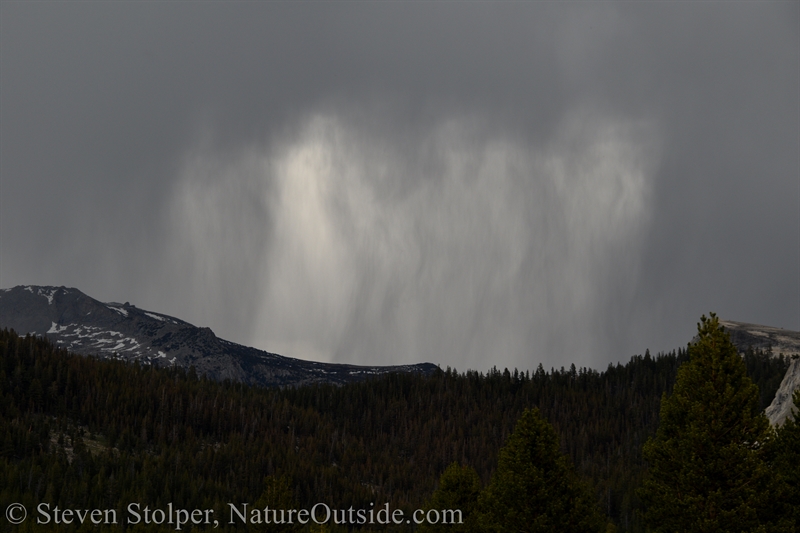
Rain in the mountains. I see the leading edge of a storm that has stretched beyond my position.
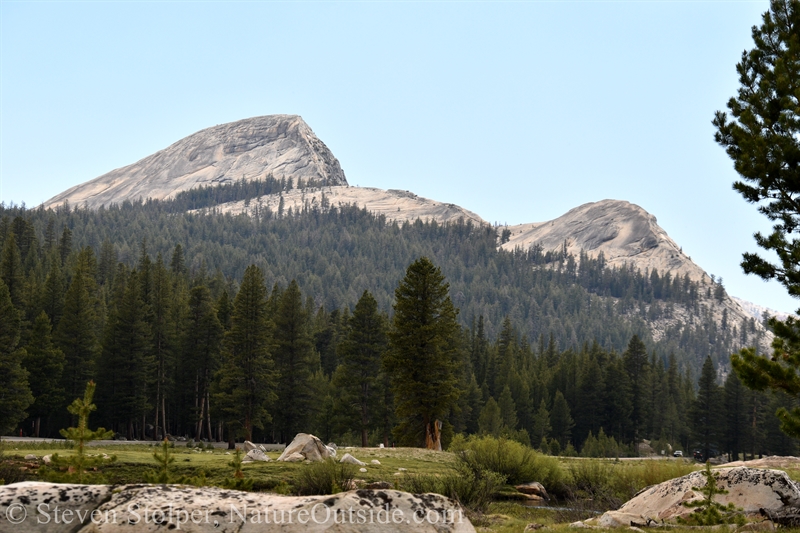
Looking Southwest, there’s not a cloud in the sky.
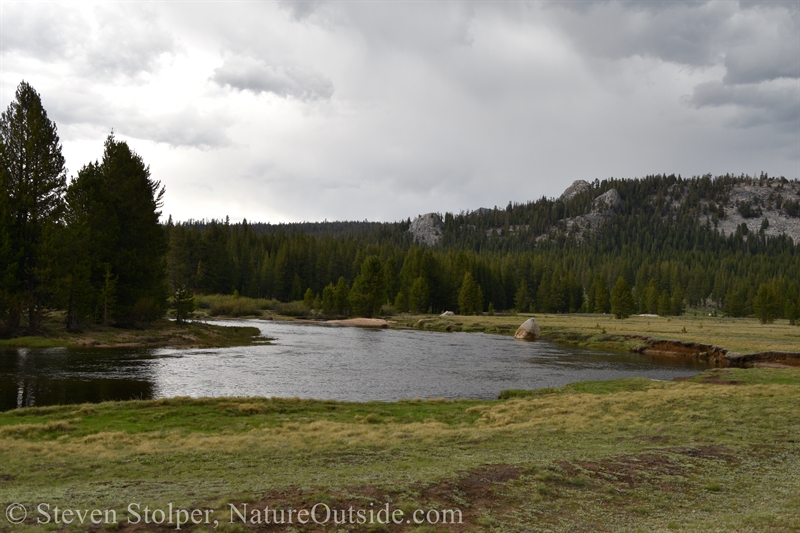
Storm clouds lumber over the Tuolumne River.
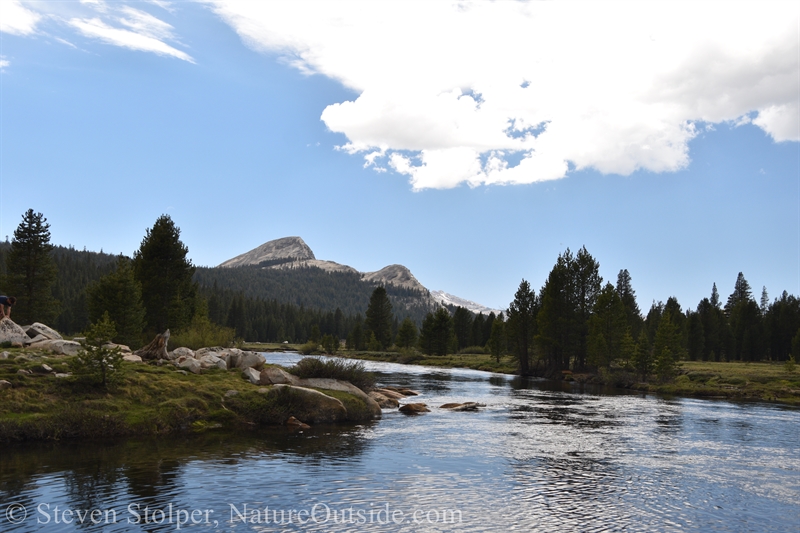
Clear skies in the opposite direction along the Tuolumne River.
I’m going to get rained on. But the storms do not appear to be severe. Most importantly, they’re not generating lightning. So I set off to explore the meadow. I won’t let a little rain put a damper on my vacation. But I’ll hang around the meadow to be safe, instead of venturing into the higher terrain.
Soda Springs
My first stop is Soda Springs, a fascinating geological feature of the meadow.
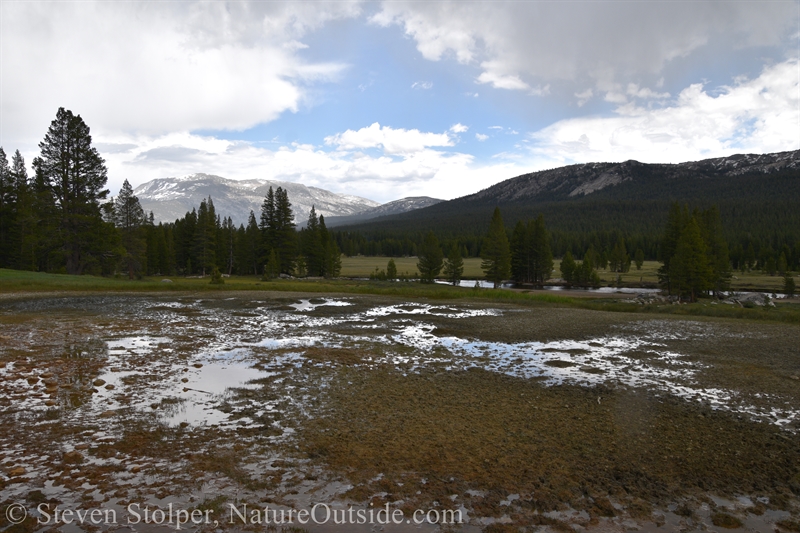
Soda Springs. Note the snow on the mountains – it is June!
Geologists are uncertain what causes pure, cold, carbonated water to bubble from the ground. And I have no good theories to offer. But it is a strange and wonderful sight.
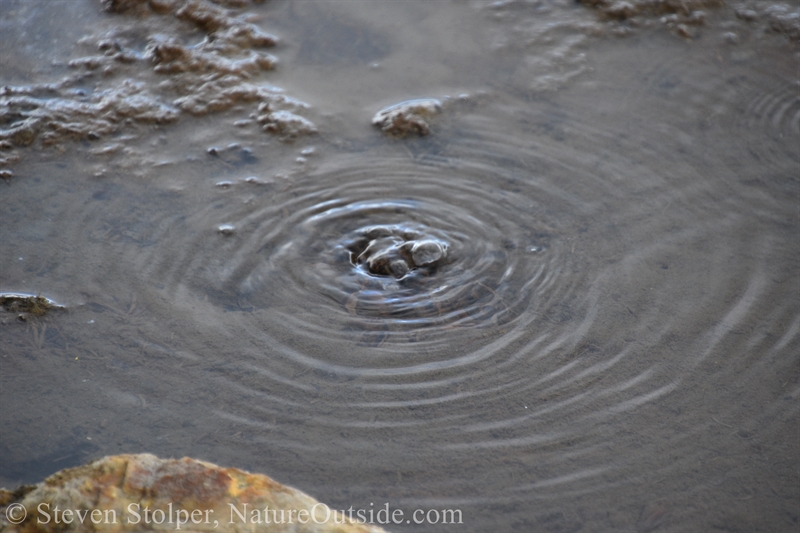
Cold carbonated water bubbles to the surface from deep within the mountains.
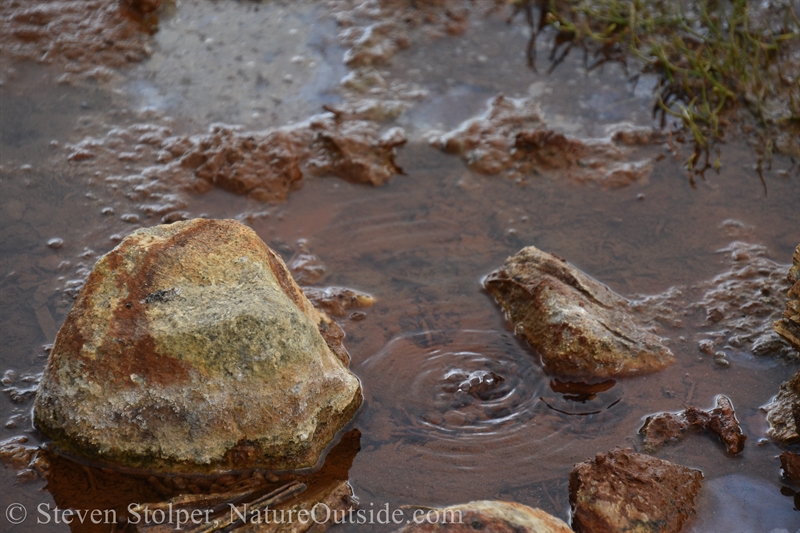
It’s strange to see bubbles suddenly appear in a pool of water. At Soda Springs, bubbles of Carbon Dioxide appear seemingly at random.
For thousands of years animals and people have visited the springs to drink. Deer and birds obtain needed minerals from the water. Around 1885, homesteader Jean Baptiste Lembert constructed a log enclosure to try to protect the springs from grazing animals. It’s ruins are still here.
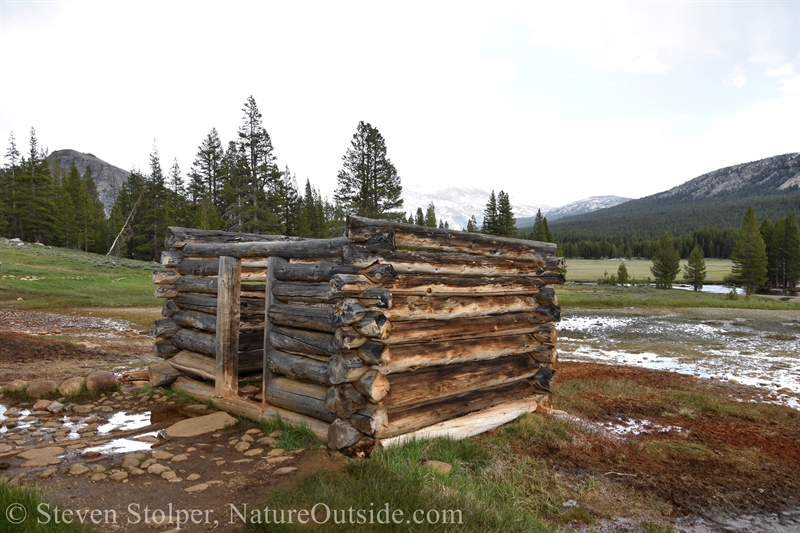
The remains of the enclosure.
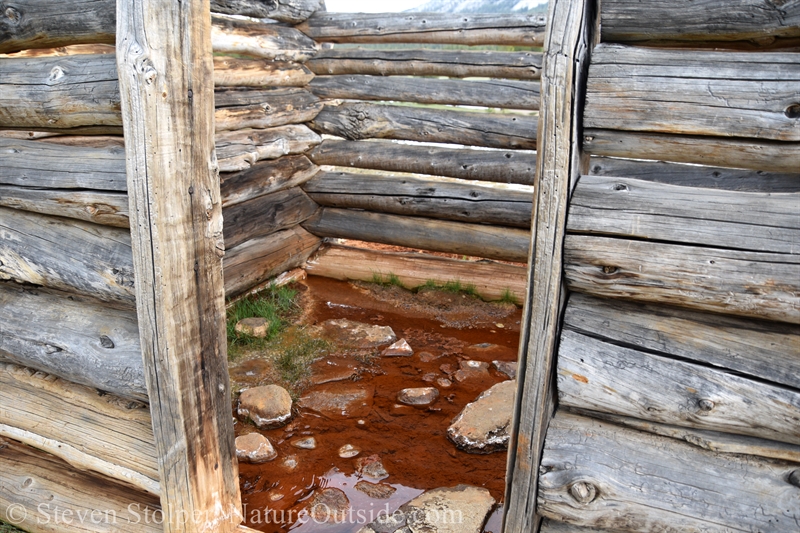
Bubbles inside the ruins.
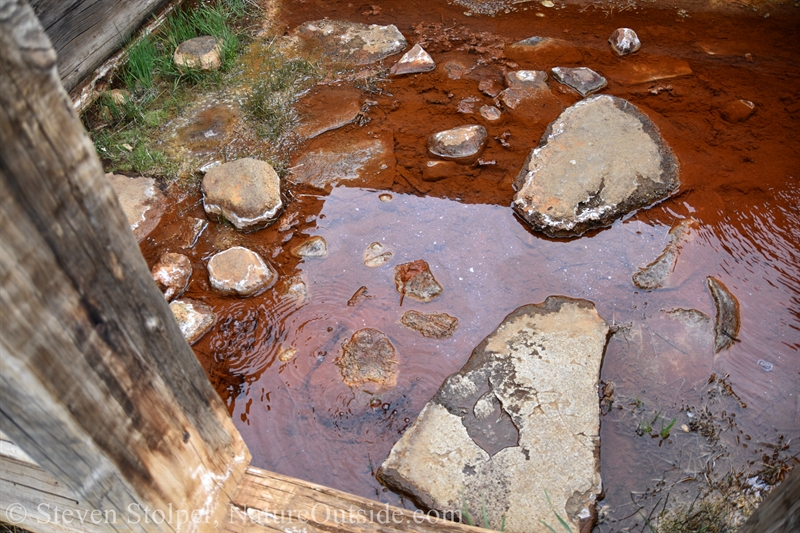
Tracks surround the springs. And it’s not just human tracks I see.
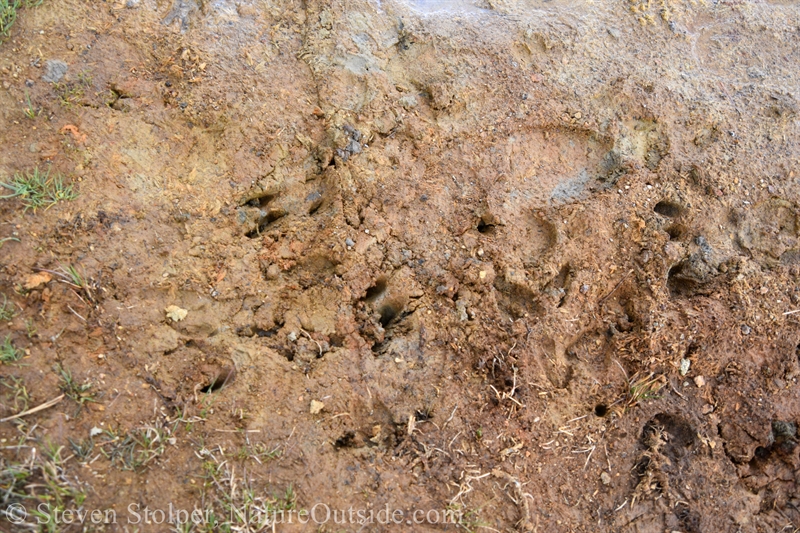
Evidence that deer still drink the water.
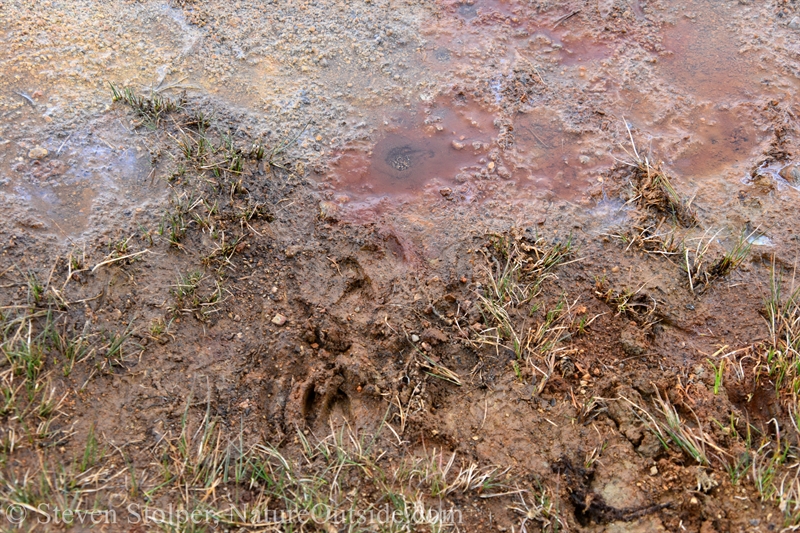
Deer tracks at Soda Springs.
The Rain Picks Up
The occasional drops have become a heavy drizzle. I’ve been wearing a fleece pullover until now, resisting the urge to don my rain jacket. There’s an old saying, “Even in rain gear you’re going to be wet.” This is because older rain gear does not allow sweat to evaporate. The rain gear traps body heat and you become wet from your sweat.
Newer rain gear is better. It has vents to let your body heat and sweat escape. And the newest technology uses gas permeable linings to let water vapor from your body escape while preventing the liquid rain from penetrating your gear. The most famous material used for these linings is Gore-Tex. However, you still get hot and a little wet when you hike in rain gear. So I delay putting it on until the rain is heavy enough to require my rain gear’s protection.
I throw on my rain jacket in the shadow of Parson’s Lodge. The main structure was built in 1915 by the Sierra Club. It was originally a meeting place and reading room. Now boarded up, its eves provide a refuge from afternoon thunderstorms.
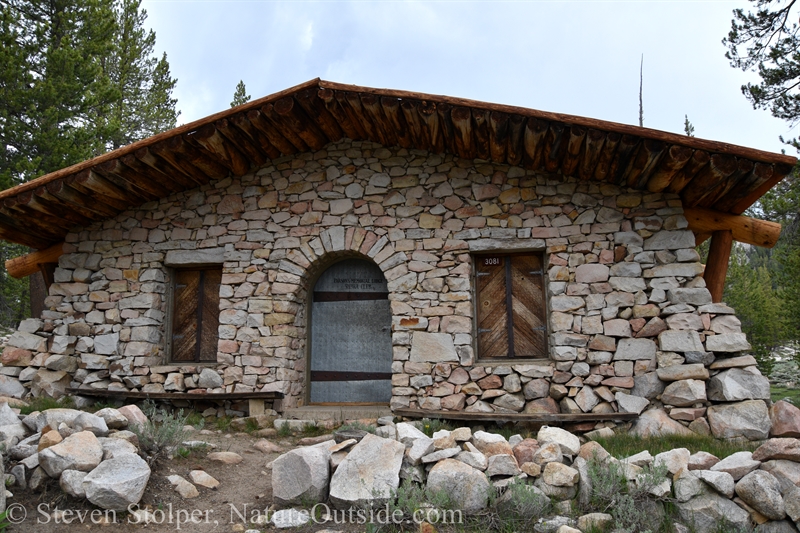
Parson’s Lodge.
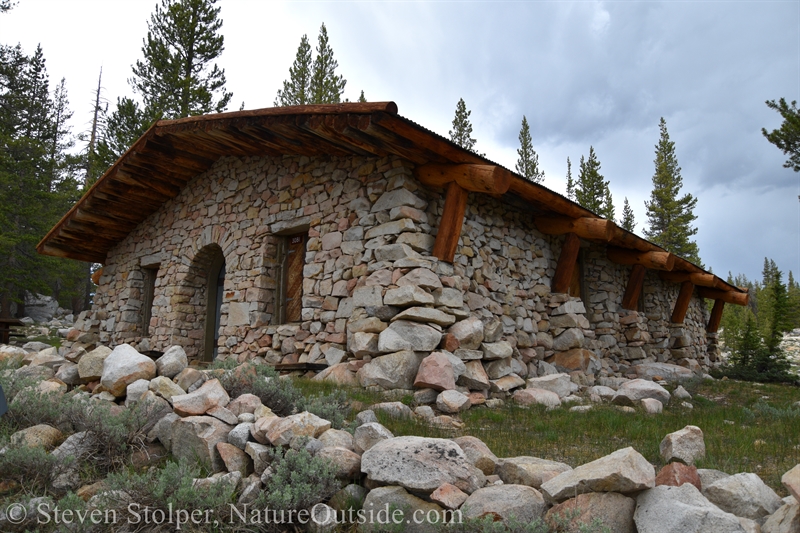
I eye the eves as a refuge from the storms if they suddenly get worse.
Notice that I’ve gradually been adding layers. I always carry thin layers that add warmth, or protect against wind and rain. This preparation is important if you go walking in the mountains. Weather is not something to be conquered. You prepare against weather. You equip against weather. And you accommodate weather. As long as you’re prepared, you can travel safely through astoundingly bad weather.
When you look at tragic stories of death in the mountains, it is usually the unprepared that perish in severe weather. If you’re prepared, you can even enjoy the experience.
Gear Up for Rain
I also take the opportunity to throw on my pack cover.
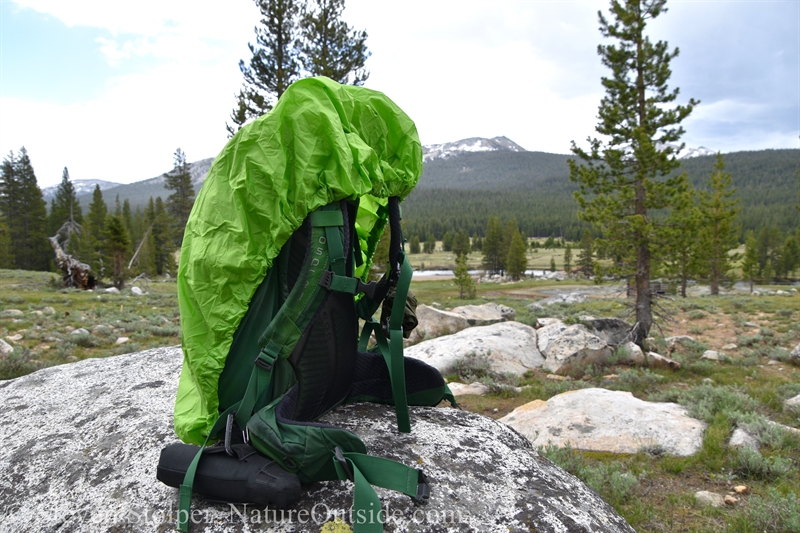
A pack cover keeps my clothes and gear dry inside my pack.
A pack cover is like a rain jacket for your backpack. It’s waterproof barrier keeps my clothing and gear dry, safe from the rain. Before I owned a pack cover, I would simply insert a trash bag into my pack’s empty main compartment. My gear went into the plastic bag. When the rain started, I could close the top of the bag. The outside of my pack would get soaked, but the contents within remained dry.
The pack cover is far more efficient. It covers external pockets and gear as well as keeping the pack dry. And I don’t need to open a plastic bag to retrieve my gear from within. If your backpack does not come with a pack cover, you can purchase them inexpensively in a size that fits your pack.
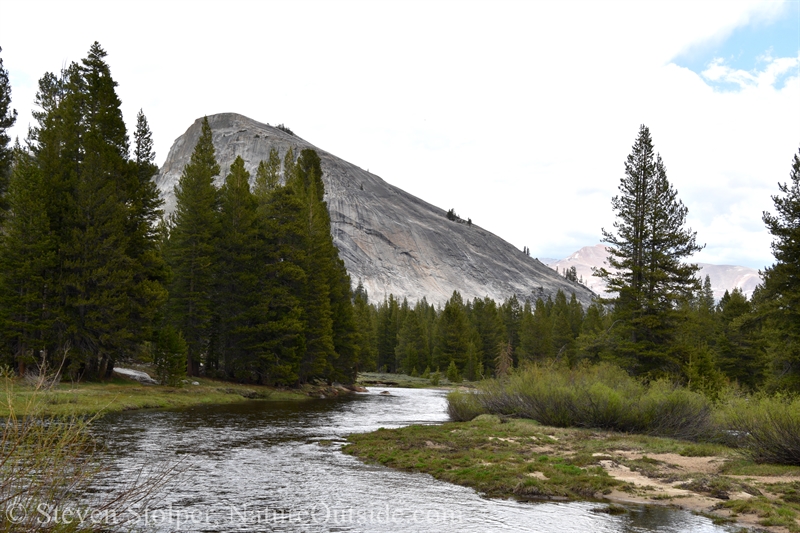
The Tuolumne River and Lembert Dome as seen through the rain.
I follow the Tuolumne River toward Lembert Dome. This route has the advantage of being close to trees I can use for shelter if the rain increases.
Invariably, it begins to pour, as I suspected it would. I enter a dense grove of trees to change into my rain pants. I lean against a rock to pull them on.
My pants have a special feature – zippers that run down the outside of each leg. This allows me to unzip the sides in each direction until the widest part of the pants leg. I can then slip them over my hiking boots and re-zip the legs. It permits me to don my rain pants without needing to remove my hiking boots. I can also let my knife’s dangler sheath hang outside my rain pants by zipping the legs in each direction to meet at my belt. The cost of the zip-up feature is weight and bulk. Most rain pants don’t have leg zippers for this reason. I choose to trade weight and bulk for the convenience and speed putting them on and taking them off.
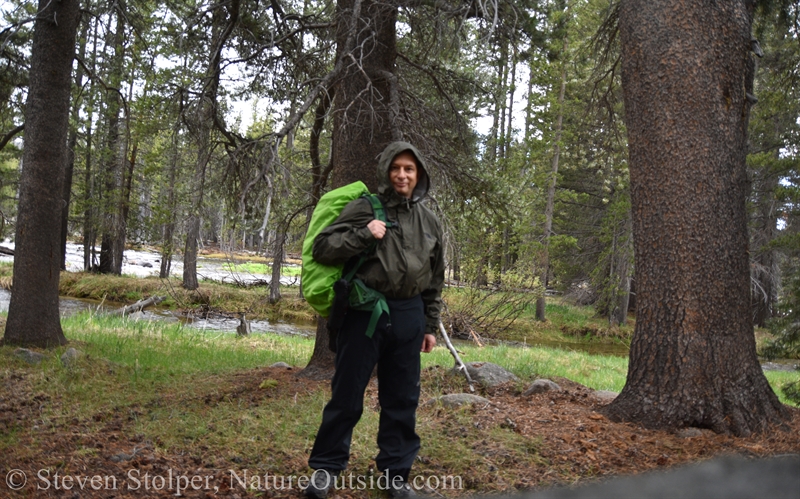
Wearing my rain gear. It’s wet outside but I am warm and dry.
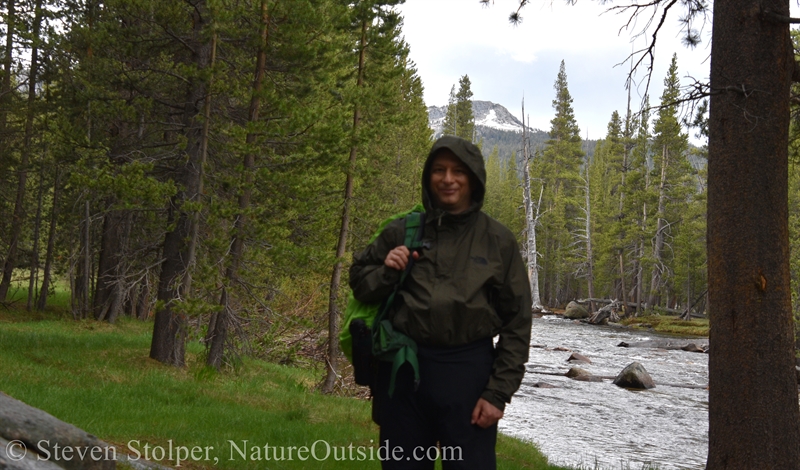
Dry and happy while it’s storming outside.
I continue my hike.
It feels like I’m the only creature stirring in the inclement weather. But then I stumble upon some black-tailed deer who eye me curiously. I can read their minds, “What is that crazy human doing out in weather like this?”
Can You Spot My Mistake?
As I hike, my rain gear feels strange. It is somehow different than normal. It’s not until I review the pictures above that I realize I’m wearing my rain gear “incorrectly.” My jacket is tucked into my pants. This creates a seam where water can seep underneath my rain gear. Usually, I make sure my jacket hangs loosely over my rain pants, covering the waist.
How could I make such a silly mistake?
Many people don’t think as well in the rain. It’s quite common for people to get rattled by bad weather and make silly mistakes. For this reason, I am extremely careful when I use my knife in rainy conditions.
When caught in the rain, slow down and keep your wits about you. I rushed to put on my rain gear and ended up looking like Steve Urkel from the television show Family Matters. It’s not a terrible mistake. But I take it as a reminder to be more deliberate when I operate in poor weather.
Prepare for Weather
Always hike with the gear you need to protect you from your local weather. Kephart says, “Only a tenderfoot will parade a scorn of comfort and a taste for useless hardships.” In other words, the experienced bushcrafter doesn’t pass up an opportunity be comfortable in the woods. He “smooths it” instead of “roughing it.” Learn from Kephart and be prepared so you are comfortable and safe in inclement weather.
Only a tenderfoot will parade a scorn of comfort and a taste for useless hardships.
– Horace Kephart
You may have the urge to discard your rain gear to save weight or bulk. But don’t find yourself unprepared. Kephart will attest that the art of going “light but right” is hard to learn. But it can be done. You can pack light without skimping on protective clothing.
The last point I want to mention is the color of your rain gear. Feel free to choose bright colors if you want to maximize your visibility during inclement weather. Bright colors will help you be found in an emergency.
I choose to wear muted colors for my own clothing because I often need to observe wildlife while wearing my rain gear. I want to keep a low profile. I tend to follow Kephart’s advice, “The color of a woodsman’s clothing should be as near invisibility as possible – unless he ranges through a country infested with fools with guns.”
If you are prepared for inclement weather you can actually enjoy the experience. It is exhilarating to be warm and dry while the weather rages around you. There is a Danish word, hygge, that expresses the concept of coziness that engenders a feeling of contentment or well-being. One of the situations often cited as creating hygge is being warm and dry in inclement weather. So the next time you go hiking, be prepared so you too can enjoy hygge.
References
The Book of Camping & Woodcraft: A Guidebook For Those Who Travel In The Wilderness
Related Article on NatureOutside
Yosemite: Living the High Life at Sentinel Dome
Yosemite National Park – Maps and Books for Hiking
The High Sierra Loop – Introduction
For fun facts and useful tips, join the free Bushcraft Newsletter.



Great article, Steve, and amazing photos. Jim & I both have the zip up water pants for one of the reasons you mention – we don’t have to take our boots off to get them on/off! I always enjoy your stories. Take care.
Thanks Ardis! I’m glad you enjoyed the article. I’m happy to trade the extra weight of the zippers and buttons for the ease in putting them on in the rain. 🙂